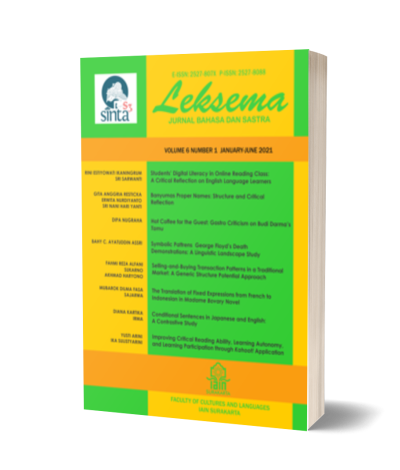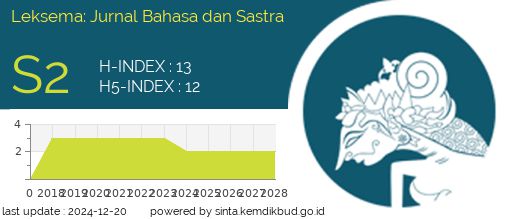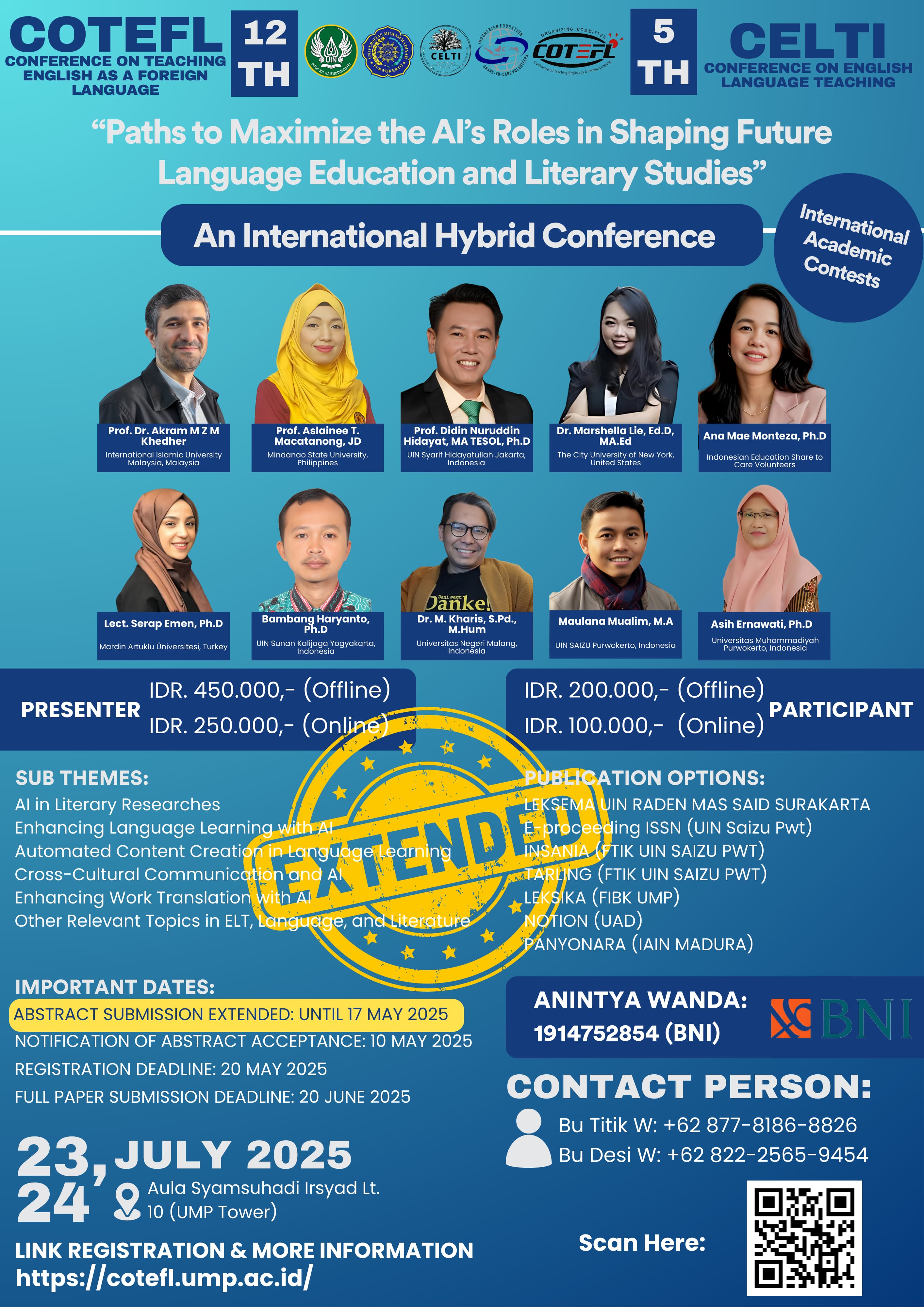SOCIAL REALITY OF RURAL SOCIETY IN 'H.A.H' DRAMA MANUSCRIPT BY PUTU WIJAYA (REALITAS SOSIAL MASYARAKAT PERKAMPUNGAN DALAM NASKAH DRAMA 'H.A.H' KARYA PUTU WIJAYA)
DOI:
https://doi.org/10.22515/ljbs.v4i2.1769Keywords:
sociology of literature, drama scripts, social realityAbstract
The drama script is a type of prose fiction literature that can not only be enjoyed through pen strokes from writers, but also aims to be performed on stage shows. In drama scripts, the topic or story that is displayed is inseparable from the life of society in general. Through the action of the cast of the cast, it is able to show that the story brought in the script seems to reflect the real life. This study aims to describe the form of reality of social life that occurs in the H.A.H drama by Putu Wijaya. This research is in the form of qualitative descriptive, with the method of analysis analysis through the sociological approach of literature. The source of the data in this study is citation text in the H.A.H drama script by Putu Wijaya, which reflects the reality of social life in the village community. Data collection techniques in this study are document techniques. While the data validity technique used in this study uses source triangulation. Triangulangi source is one of the validity test data that is suitable for use in this study. After analysis, the results of this study show that Putu Wijaya's H.A.H drama script reflects the social life of the community such as: moral degradation, cultural shifts, social conflict, crime. This is due to weak economic conditions, lack of understanding of religious teachings about faith, faith and piety, and lack of education.
Downloads
References
Amriani, H. 2014. "Realitas Sosial Dalam Novel Ronggeng Dukuh Paruk Karya Ahmad Tohari". Sawerigading, 20 (1), 99-108
Aulina, A. 2017. "Kejahatan di Wilayah Perkotaan dan Model Integratif Pencegahan Kejahatan". Jurnal Ilmu Kepolisian, 11 (3): 6-15
Endawarsana, S. 2012. Teori Pengkajian Sosiologi Sastra. Yogyakarta: UNY Press
Endawarsana, S. 2013a. Metodologi Kritik Sastra. Yogyakarta: Penerbit Ombak
Endawarsana, S. 2013b. Sosiologi Sastra: Studi, Teori, dan Interpretasi. Yogyakarta: Penerbit Ombak
Faruk. 2015. Pengantar Sosiologi Sastra: dari Strukturalisme Genetik sampai Post-Modernisme. Yogyakarta: Pustaka Pelajar
Habibah, S. 2018. "Filsafat Pendidikan Islam dan Tameng Moralitas Bangsa". Ta'lim : Jurnal Studi Pendidikan Islam, 1(1): 40-58
Ibda, F. 2012. "Pendidikan Moral Anak Melalui Pengajaran Bidang Studi PPKN dan Pendidikan Agama". Didaktika 12 (2): 338-347
Irma, CN. 2018. "Nilai-Nilai Pendidikan Karakter Dalam Novel Ibuk Karya Iwan Setyawan". Retorika, 11 (1): 14-22. https://doi.org/10.26858/retorika.v11i1.4888
Moleong, LJ. 2013. Metodologi Penelitian Kualitatif Edisi Revisi. Bandung: PT Remaja Rosdakarya
Mujiyanto, Y & A. Fuady. 2014. Kitab Sejarah Sastra Indonesia. Yogyakarta: Penerbit Ombak
Nugroho, YD. 2018. "Penerapan Regresi Logistik Hierarki Biner Untuk Menentukan Determinan Kemiskinan Di Bengkulu Dengan Menggunakan Indeks Aksesibiltas Sarana Umum (IASU) Sebagai Variabel Kontekstual". dalam Pendidikan Matematika Universitas Muhammadiyah Purworejo - Ruang Seminar UMP: 249-261
Nuryani, L, BS Agus, & P Dhika. 2018. "Variasi Bahasa Pada Pementasan Drama Cipoa dan Sidang Para Setan Mahasiswa Pendidikan Bahasa dan Sastra Indonesia Tahun 2017". Widyabastra, 6 (1):62-75
Prihantono, KD. 2018. "Pergeseran Identitas Budaya Dalam Naskah Lakon Putu Wijaya Bila Malam Bertambah Malam: Kajian Pascamodernisme". Alayasastra, 14 (1): 39-52
Pujiharto. 2012. Pengantar Teori Fiksi. Yogyakarta: Penerbit Ombak
Rokhmansyah, A. 2014. Studi dan Pengkajian Sastra: Perkenalan Awal Terhadap Ilmu Sastra. Yogyakarta: Graha Ilmu
Sapendi. 2015. "Internalisasi Nilai-Nilai Moral Agama Pada Anak Usia Dini". At Turats, 9 (2):17-35
Syam, NK. 2014. "Kearifan Dakwah dan Konflik Sosial". dalam Prosiding Seminar Nasional Penelitian dan PKM Sosial, Ekonomi dan Humaniora: 115-120)
Downloads
Published
Issue
Section
License
The copyright of the received article shall be assigned to the publisher of the journal. The intended copyright includes the right to publish the article in various forms (including reprints). The journal maintains the publishing rights to published articles.
In line with the license, the authors and users (readers or other researchers) are allowed to share and adapt the material only for non-commercial purposes. In addition, the material must be given appropriate credit, provided with a link to the license, and indicated if changes were made. If authors remix, transform or build upon the material, authors must distribute their contributions under the same license as the original.






